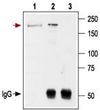Grin2b Rabbit Polyclonal Antibody
Frequently bought together (1)
beta Actin Mouse Monoclonal Antibody, Clone OTI1, Loading Control
USD 200.00
Other products for "Grin2b"
Specifications
| Product Data | |
| Applications | IHC, IP, WB |
| Recommended Dilution | WB: 1:200-1:2000; IHC: 1:100-1:3000 |
| Reactivities | Human, Mouse, Rat |
| Host | Rabbit |
| Clonality | Polyclonal |
| Immunogen | Peptide (C)NTHEKRIYQSNMLNR, corresponding to amino acid residues 323-337 of rat NMDA Receptor 2B . Extracellular, N-terminus. |
| Formulation | Lyophilized. Concentration before lyophilization ~0.8mg/ml (lot dependent, please refer to CoA along with shipment for actual concentration). Buffer before lyophilization: Phosphate buffered saline (PBS), pH 7.4, 1% BSA, 0.025% NaN3. |
| Reconstitution Method | Add 50 ul double distilled water (DDW) to the lyophilized powder. |
| Purification | Affinity purified on immobilized antigen. |
| Conjugation | Unconjugated |
| Storage | Store at -20°C as received. |
| Stability | Stable for 12 months from date of receipt. |
| Gene Name | glutamate ionotropic receptor NMDA type subunit 2B |
| Database Link | |
| Background | The NMDA receptors are members of the glutamate receptor family of ion channels that also include the AMPA and Kainate receptors. The NMDA receptors are encoded by seven genes: one NMDAR1 (or NR1) subunit, four NR2 (NR2A-NR2D) and two NR3 (NR3A-NR3B) subunits. The functional NMDA receptor appears to be a heterotetramer composed of two NMDAR1 and two NMDAR2 subunits. Whereas the NMDAR2 subunits that assemble with the NMDAR1 subunit can be either of the same kind (i.e. two NMDAR2A subunits) or different (one NMDAR2A with one NMDAR2B). NMDAR3 subunits can substitute the NMDAR2 subunits in their complex with the NMDAR1 subunit. The NMDAR is unique among ligand-gated ion channels in that it requires the simultaneous binding of two obligatory agonists: glycine and glutamate that bind to the NMDAR1 and NMDAR2 binding sites respectively. Another unique characteristic of the NMDA receptors is their dependence on membrane potential. At resting membrane potentials the channels are blocked by extracellular Mg2+. Neuronal depolarization relieves the Mg2+ blockage and allows ion influx into the cells. NMDA receptors are strongly selective for Ca2+ influx differing from the other glutamate receptor ion channels that are non-selective cation channels. Ca2+ entry through the NMDAR regulates numerous downstream signaling pathways including long term potentiation (a molecular model of memory) and synaptic plasticity that may underlie learning. In addition, the NMDA receptors have been implicated in a variety of neurological disorders including epilepsy, ischemic brain damage, Parkinson’s and Alzheimerâ??s disease. NMDA receptors expression and function are modulated by a variety of factors including receptor trafficking to the synapses and internalization as well as phosphorylation and interaction with other intracellular proteins. |
| Synonyms | hNR3; MGC142178; MGC142180; NMDAR2B; NR2B; NR3 |
| Reference Data | |
Documents
| Product Manuals |
| FAQs |
| SDS |
{0} Product Review(s)
0 Product Review(s)
Submit review
Be the first one to submit a review
Product Citations
*Delivery time may vary from web posted schedule. Occasional delays may occur due to unforeseen
complexities in the preparation of your product. International customers may expect an additional 1-2 weeks
in shipping.






























































































































































































































































 Germany
Germany
 Japan
Japan
 United Kingdom
United Kingdom
 China
China






